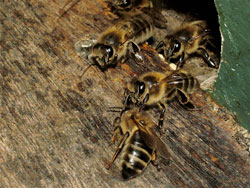A nest of honey bees, Apis mellifera, or other social insects contains workers, brood and stored food. As such, it is a potential target for a wide range of harmful intruders including predators, parasites and robbers. Intruders range from mammals to other insects. In Britain, one of the most harmful intruders is the common wasp, Vespula vulgaris. When wasp numbers are high in late summer and early autumn, they frequently kill honey bee colonies. In many species, among the most serious intruders are members of the same species from other colonies. Honey bees frequently rob stored honey from other hives. Robbing is especially common during 'dearth' periods when the weather is warm enough for flight but there are few flowers. Robbing can easily kill the victim colony, which starves. Ants can also be their own worst enemies. A colony's foraging territory often adjoins a neighbouring territory of the same species, leading to territorial battles and nest raiding.
 Task partitioning in honey bees.
Task partitioning in honey bees.
Given these problems, it is not surprising that the nests of social insects are usually well defended. The nest is often built in a cavity with a narrow entrance, and the entrance is generally defended by 'guard' workers. The entrance of a honey bee colony will usually have five to ten guards patrolling and checking incomers with their antennae. The guards are just normal worker bees, but have specialised behaviour. In many ants and termites the guards have large heads armed with powerful jaws.
A major requirement in nest defence is for guards to discriminate nestmates from non-nestmates. This is known as nestmate recognition, and is especially challenging in the recognition of intruders of the same species. LASI research investigates a wide variety of questions in nestmate recognition. One area is flexibility in guard thresholds. When robbing is more prevalent, guard honey bees adopt a less permissive acceptance threshold rejecting more non-nestmates but also rejecting more nestmates. Guards are able to change their acceptance threshold very rapidly in response to sudden increases in robbing intensity.
 Students working on a nest guarding project
Students working on a nest guarding project
Another important question is how guards know whether an incomer is a nestmate or not. Intruders of other species are recognised because they are not honey bees, not because they are specifically harmful. Thus, harmless insects such as ladybird beetles are rejected just as strongly as harmful wasps. Intruders of the same species are recognised as nestmates versus non-nestmates by means of an 'undesirable-absent' rule. That is, guards learn their 'colony odour' and reject incomers who have odours not present in colony odour. This is shown by contaminating worker bees with the odour of workers from other colonies. When nestmate workers are given odours from another colony they are rejected by their own guards. But non-nestmate workers are not accepted when given an equivalent amount of nestmate odour. The use of a U-absent rule may be general in social insects. LASI research has shown that it occurs in the honey bee and two species of Brazilian stingless bees, Frieseomelitta varia and Tetragonisca angustula.


